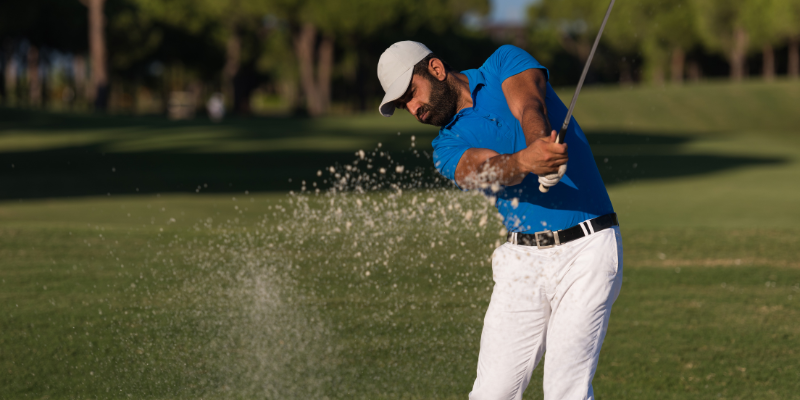Αν και το γκολφ μπορεί να φαίνεται αργό σε κάποιους, στην πραγματικότητα είναι ένα άκρως ανταγωνιστικό άθλημα που απαιτεί πολλές δεξιότητες. Ένας τρόπος για να μετρηθεί αυτή η δεξιότητα είναι να προσδιοριστεί αν κάποιος είναι "παίκτης του γκολφ". Αν αναρωτιέστε - τι είναι ο γκόλφερ scratch, βρίσκεστε στο σωστό μέρος.
Σε αυτόν τον οδηγό, θα σας εξηγήσουμε τι είναι ο γκολφέρ scratch, από πού προέρχεται ο όρος, πόσος χρόνος μπορεί να χρειαστεί για να γίνετε γκολφέρ και τις διαφορές μεταξύ των γκολφέρ scratch και των επαγγελματιών παικτών.
Ας ξεκινήσουμε και ας μάθουμε τα πάντα για τους παίκτες του γκολφ.
Τι είναι το Scratch στο γκολφ;
Τι είναι το scratch στο γκολφ; Στο γκολφ αναφέρεται συνήθως σε κάποιον με χάντικαπ 0 ή χαμηλότερο. Για όσους δεν είναι εξοικειωμένοι με τα χάντικαπ, ένας γκολφέρ με μηδενισμό πετυχαίνει σταθερά par ή καλύτερα σε ένα κανονικό γήπεδο.
Οι παίκτες του γκολφ που συζητούν για το χάντικαπ, μπορεί απλά να λένε ότι κάποιος είναι "scratch" για να δηλώσουν ότι το χάντικαπ του είναι 0.

Για παράδειγμα, αν κάποιος ερωτηθεί για την αναπηρία του Τομ, θα μπορούσε να απαντήσει: "Είναι μηδενικός". Αυτή η συντομογραφία υποδηλώνει ότι το χάντικαπ του Τομ βρίσκεται στο επίπεδο όπου συνήθως παίζει γκολφ με par ή καλύτερα. Επίσης, μπορείτε να διαβάσετε περισσότερα για συν το μειονέκτημα.
Ορισμός του "Scratch Golfer" που παρέχεται από την USGA και άλλους
Σύμφωνα με το USGA και άλλους κυβερνητικούς φορείς, ως "παίκτης γκολφ με μηδενική βαθμολογία" ορίζεται ένας παίκτης ικανός να επιτύχει μηδενικό χάντικαπ σε οποιοδήποτε βαθμολογημένο γήπεδο γκολφ.
Για σκοπούς αξιολόγησης, οι άντρες παίκτες γκολφ συνήθως οδηγούν τα χτυπήματα τσαγιού κατά μέσο όρο σε 250 γιάρδες και μπορούν να φτάσουν σε μια τρύπα 470 γιάρδων σε δύο χτυπήματα στο επίπεδο της θάλασσας.
Από την άλλη πλευρά, οι γυναίκες που παίζουν γκολφ, συνήθως χτυπούν κατά μέσο όρο 210 γιάρδες και μπορούν να φτάσουν σε μια τρύπα 400 γιάρδων σε δύο χτυπήματα στο επίπεδο της θάλασσας.
Είναι σημαντικό να επισημάνουμε την αρχή του ορισμού της USGA, τονίζοντας ότι ένας παίκτης του γκολφ scratch μπορεί να παίξει σε επίπεδο par. Ωστόσο, στην πραγματικότητα, κάποιος με δείκτη χάντικαπ 0 έχει κατά μέσο όρο περίπου 74-75 για το μέσο όρο του σκορ του καθ' όλη τη διάρκεια του έτους, υπό την προϋπόθεση ότι παίζει περισσότερα από το γήπεδο του σπιτιού του.
Ενώ οι παίκτες του γκολφ μπορεί να μην αποδίδουν με συνέπεια στο επίπεδο των επαγγελματιών γκολφέρ, ξεπερνούν το επίπεδο δεξιοτήτων σχεδόν 99% των ερασιτεχνών παικτών και έχουν την ικανότητα να πετύχουν par ή καλύτερα σε οποιοδήποτε γήπεδο.
Στις Ηνωμένες Πολιτείες, μόνο 1,5% των ανδρών παικτών γκολφ διατηρούν δείκτη χάντικαπ "0" ή καλύτερο, ενώ το ποσοστό των γυναικών παικτών είναι ακόμη χαμηλότερο, 0,5%.
Αυτή η διάκριση προορίζεται για τους παίκτες της ελίτ και μπορεί να δηλωθεί ως "συν ____ χάντικαπ". Η επίτευξη ενός "μηδενικού και καλύτερου χάντικαπ" είναι σπάνια, αλλά για τους παίκτες που ξεπερνούν το επίπεδο scratch, μεταβαίνουν σε ένα "συν" χάντικαπ.
Μόλις μπουν στην κατηγορία "συν", οι παίκτες πρέπει να προσαρμόσουν τα αποτελέσματά τους ώστε να υπολογίσουν την επιστροφή των χτυπημάτων στο γήπεδο πριν από το tee off, που σηματοδοτείται από το "+" στην αρχή του χάντικαπ.
Αυτοί οι παίκτες αναμένεται να σπάνε σταθερά το par στο γήπεδο της χώρας τους και να προσαρμόζουν το σκορ τους ανάλογα.
Η διαφορά: Pros και Scratch Golfers
- Ο όρος "scratch golfer" αναφέρεται σε έναν παίκτη γκολφ που συνήθως πετυχαίνει ακόμη και par (ή καλύτερα) σε ένα τυπικό γήπεδο, που σημαίνει ότι το σκορ του ταιριάζει με τη βαθμολογία και την κλίση του γηπέδου.
- Αντίθετα, ένας "επαγγελματίας" παίκτης του γκολφ είναι κάποιος που παίζει γκολφ για τα προς το ζην, συμμετέχοντας σε τουρνουά και κερδίζοντας συχνά χρήματα από χορηγίες, χορηγίες και έπαθλα.
Εδώ είναι μερικές βασικές διαφορές μεταξύ των επαγγελματιών και των παικτών του γκολφ:
1. Επίπεδο δεξιοτήτων
Ενώ τόσο οι παίκτες του γκολφ με μηδενική συμμετοχή όσο και οι επαγγελματίες είναι παίκτες με υψηλή εξειδίκευση, οι επαγγελματίες παίκτες του γκολφ συνήθως λειτουργούν σε υψηλότερο επίπεδο δεξιοτήτων. Έχουν τελειοποιήσει το παιχνίδι τους για να ανταγωνίζονται στα υψηλότερα επίπεδα του αθλήματος, ξοδεύοντας συχνά αμέτρητες ώρες εξάσκησης και τελειοποίησης των τεχνικών τους.
2. Εμπειρία
Οι επαγγελματίες συνήθως παίζουν γκολφ ανταγωνιστικά για πολλά χρόνια, συχνά ξεκινώντας από νεαρή ηλικία. Έχουν εκτεταμένη εμπειρία στο παιχνίδι σε τουρνουά, στην αντιμετώπιση καταστάσεων πίεσης και στη διαχείριση του παιχνιδιού τους υπό διάφορες συνθήκες.
3. Εκπαίδευση και προπόνηση
Οι επαγγελματίες έχουν συχνά πρόσβαση σε κορυφαίες εγκαταστάσεις προπόνησης, προπονητές και προσωπικό υποστήριξης για να τους βοηθήσουν να βελτιώσουν το παιχνίδι τους. Μπορούν επίσης να λάβουν καθοδήγηση σχετικά με τη φυσική κατάσταση, τη διατροφή, την πνευματική προετοιμασία και άλλες πτυχές που είναι ζωτικής σημασίας για την κορυφαία απόδοση.
4. Διαγωνισμός
Ενώ οι παίκτες του γκολφ μπορεί να αγωνίζονται σε τοπικά τουρνουά ή ερασιτεχνικές διοργανώσεις, οι επαγγελματίες παίκτες του γκολφ ανταγωνίζονται τακτικά μερικούς από τους καλύτερους παίκτες στον κόσμο σε περιοδείες όπως το PGA Tour, το European Tour, το LPGA Tour κ.λπ.
Το επίπεδο του ανταγωνισμού και το διακύβευμα είναι συνήθως πολύ υψηλότερο για τους επαγγελματίες.
6. Έσοδα και χορηγίες
Οι επαγγελματίες παίκτες του γκολφ κερδίζουν τα προς το ζην μέσω του γκολφ, λαμβάνοντας εισόδημα από τα κέρδη των τουρνουά, τις χορηγίες, τις αμοιβές εμφάνισης, τις διαφημίσεις και άλλες πηγές. Αντίθετα, οι παίκτες του γκολφ μπορεί να έχουν άλλες καριέρες ή πηγές εισοδήματος εκτός του γκολφ.
7. Δέσμευση
Το να γίνεις ένας επιτυχημένος επαγγελματίας παίκτης του γκολφ απαιτεί τεράστια αφοσίωση, θυσίες και επιμονή. Πολλοί επαγγελματίες αφιερώνουν ολόκληρη τη ζωή τους στο άθλημα, ταξιδεύοντας συχνά εκτεταμένα και περνώντας πολλές ώρες στην προπόνηση ή στο γήπεδο.
8. Πίεση
Ενώ οι παίκτες του γκολφ που παίζουν μόνοι τους μπορεί να αισθάνονται πίεση στον αγώνα, οι επαγγελματίες αντιμετωπίζουν αυξημένη πίεση λόγω των προσδοκιών των φιλάθλων, των χορηγών, του ελέγχου των μέσων ενημέρωσης και των οικονομικών επιπτώσεων της απόδοσής τους. Η εκμάθηση του χειρισμού της πίεσης και της απόδοσης υπό πίεση είναι μια κρίσιμη δεξιότητα για τους επαγγελματίες παίκτες του γκολφ.

Πόσο καιρό χρειάζεται για να γίνω ένας γκολφέρ Scratch;
Η διάρκεια για να φτάσει κανείς σε ένα επίπεδο γκόλφερ scratch διαφέρει σημαντικά λόγω διαφόρων στοιχείων, όπως η έμφυτη ικανότητα, η δέσμευση για τακτική προπόνηση, η διαθεσιμότητα καλής προπόνησης, η φυσική κατάσταση, η στρατηγική νοοτροπίας και οι αρχικές ικανότητες του γκολφ.
Για ορισμένα εξαιρετικά ταλαντούχα άτομα που ξεκινούν σε νεαρή ηλικία και έχουν πρόσβαση σε κορυφαία προπόνηση και εγκαταστάσεις, η επίτευξη της ιδιότητας του scratch golfer μπορεί να είναι εφικτή μέσα σε λίγα χρόνια.
Ωστόσο, για τους περισσότερους ανθρώπους, συνήθως χρειάζονται πολλά χρόνια συνεπούς εξάσκησης και βελτίωσης για να φτάσουν σε αυτό το επίπεδο.
Ακολουθούν ορισμένοι γενικοί παράγοντες που μπορούν να επηρεάσουν το χρόνο που χρειάζεται για να γίνει κάποιος παίκτης του γκολφ:
- Επίπεδο αρχικών δεξιοτήτων
Εάν έχετε προηγούμενη εμπειρία στο γκολφ ή έχετε αναπτύξει δεξιότητες σε συναφή αθλήματα, όπως ο στίβος ή άλλα αθλήματα ακριβείας, μπορεί να προοδεύσετε πιο γρήγορα από κάποιον που ξεκινά από το μηδέν.
- Αγωγή πρακτικής
Η συνεπής και εστιασμένη εξάσκηση είναι ζωτικής σημασίας για τη βελτίωση στο γκολφ. Η τακτική ενασχόληση με το γήπεδο οδήγησης, η εργασία σε όλες τις πτυχές του παιχνιδιού (ντράιβ, χτυπήματα προσέγγισης, τσίπινγκ, putting, κ.λπ.) και οι γύροι στο γήπεδο μπορούν να επιταχύνουν την πρόοδο.
- Ποιοτική διδασκαλία
Η συνεργασία με έναν έμπειρο δάσκαλο γκολφ που μπορεί να παρέχει ανατροφοδότηση, καθοδήγηση και ασκήσεις προσαρμοσμένες στις ατομικές σας ανάγκες μπορεί να σας βοηθήσει να βελτιωθείτε πιο αποτελεσματικά από το να προσπαθείτε να μάθετε μόνοι σας.
- Φυσική κατάσταση
Το γκολφ απαιτεί ένα συνδυασμό δεξιοτήτων, συντονισμού, ευελιξίας και δύναμης. Η ενασχόληση με ένα πρόγραμμα γυμναστικής που ενισχύει τις σωματικές σας ικανότητες μπορεί να συμβάλει στην καλύτερη απόδοση στο γήπεδο.
- Διανοητικό παιχνίδι
Η ανάπτυξη μιας ισχυρής ψυχικής προσέγγισης στο γκολφ, συμπεριλαμβανομένης της διαχείρισης του γηπέδου, της λήψης αποφάσεων, της συγκέντρωσης, της ανθεκτικότητας και της διαχείρισης της πίεσης, είναι απαραίτητη για την επίτευξη της ιδιότητας του γκολφέρ scratch.
- Εμπειρία στον ανταγωνισμό
Η συμμετοχή σε τουρνουά ή άλλες ανταγωνιστικές μορφές μπορεί να σας βοηθήσει να αποκτήσετε πολύτιμη εμπειρία, να μάθετε να διαχειρίζεστε τα νεύρα σας και να εντοπίσετε τομείς για βελτίωση.
Πόσοι γκολφέρ Scratch υπάρχουν;
Σύμφωνα με την USGA, το 1,6% των ανδρών γκολφέρ έχουν ένα USGA Δείκτης χάντικαπ μηδέν ή καλύτερος. Μεταξύ των γυναικών παικτών γκολφ, το ποσοστό είναι ακόμη μικρότερο: 0,37 τοις εκατό. Έτσι, το ποσοστό των παικτών γκολφ που είναι μηδενιστές είναι πολύ, πολύ μικρό.
Τι γίνεται με τους παίκτες του γκολφ που δεν έχουν επίσημους δείκτες χάντικαπ;
Δεν υπάρχει τρόπος να γνωρίζουμε με βεβαιότητα, αλλά μπορούμε να πούμε το εξής: Το ποσοστό είναι ακόμη χαμηλότερο. Εξάλλου, αν είστε πραγματικά τόσο καλός, δεν θέλετε να το ξέρουν όλοι; (Κάτι άλλο που μπορούμε να πούμε με βεβαιότητα για τους ανάπηρους ερασιτέχνες παίκτες του γκολφ: Πολύ λιγότεροι είναι παίκτες του γκολφ scratch απ' ό,τι ισχυρίζονται ότι είναι).
Συμπέρασμα
Εν κατακλείδι, ένας γκολφέρ scratch είναι κάποιος με εξαιρετικές ικανότητες, ικανός να πετυχαίνει σταθερά par ή καλύτερα σε ένα κανονικό γήπεδο γκολφ.
Η επίτευξη της ιδιότητας του scratch απαιτεί αφοσίωση στην πρακτική, πρόσβαση σε ποιοτική διδασκαλία και συχνά πολυετή προσπάθεια.
Καθώς μόνο ένα μικρό ποσοστό των παικτών του γκολφ φτάνει σε αυτό το επίπεδο, το να είσαι παίκτης του γκολφ scratch σηματοδοτεί ένα υψηλό επίπεδο επάρκειας στο παιχνίδι.
F.A.Q
Τι είναι ένας γκόλφερ του γκολφ❓
Ένας παίκτης του γκολφ που ξεχωρίζει για τις εξαιρετικές ικανότητές του, πυροβολώντας σταθερά με par ή καλύτερα, σε αντίθεση με άλλους παίκτες που μπορεί να έχουν υψηλότερο χάντικαπ και συνήθως πυροβολούν πάνω από par.
Πόσο καιρό χρειάζεται για να γίνεις γκόλφερ του γκολφ❓
Ο χρόνος για να γίνει κάποιος παίκτης του γκολφ ποικίλλει, ανάλογα με παράγοντες όπως το φυσικό ταλέντο, η αφοσίωση στην εξάσκηση, η πρόσβαση στην προπόνηση και το αρχικό επίπεδο δεξιοτήτων. Ενώ κάποιοι μπορεί να το πετύχουν σε λίγα χρόνια, για τους περισσότερους χρειάζονται πολλά χρόνια συνεπούς προσπάθειας.
Ποια είναι η διαφορά μεταξύ του γκολφ με μηδενικό χάντικαπ και του γκολφ με χαμηλό χάντικαπ❓
Απαντήστε: Ένας γκόλφερ με μηδενικό χάντικαπ, ενώ ένας γκόλφερ με χαμηλό χάντικαπ έχει συνήθως χάντικαπ μεταξύ 1 και 5.
Ποια είναι η διαφορά μεταξύ ενός παίκτη γκολφ και άλλων παικτών❓
Ένας παίκτης του γκολφ που ξεχωρίζει για τις εξαιρετικές ικανότητές του, πυροβολώντας σταθερά με par ή καλύτερα, σε αντίθεση με άλλους παίκτες που μπορεί να έχουν υψηλότερο χάντικαπ και συνήθως πυροβολούν πάνω από par.
Τι σημαίνει γκολφέρ μηδέν❓
Ο όρος scratch golfer χρησιμοποιείται στο γκολφ για να περιγράψει έναν παίκτη που έχει δείκτη χάντικαπ μηδέν- συνήθως πετυχαίνει par ή καλύτερα στα περισσότερα γήπεδα.